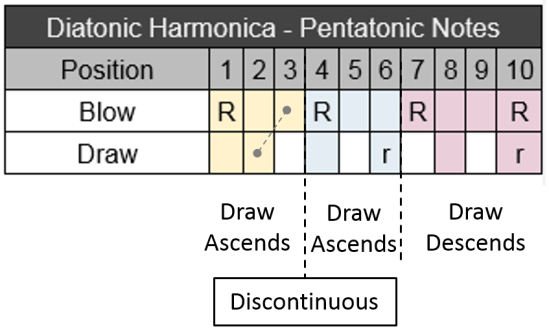For most people, the easiest way to dig in and start making music using most instruments — especially for improvisation — is to gain a good working knowledge of the Pentatonic Scale and how to play it on that instrument. Unfortunately, the standard diatonic harmonica is kind of oddly setup for playing these scales. I’ve read that this has to do with the music it was originally designed to play — German Oompah music. It was meant to provide “a whole band in your pocket!” Never mind that it has become the standard for blues, folk and classic rock, but that leaves it up to us to figure out how to play it! Below is a chart that I put together simply because I couldn’t find one online anywhere.

I’ve blocked out all the notes for the Pentatonic scale in various colors (one for each octave). Note that the root notes (R) are located at 1, 4, 7 and 10-blows. For a standard C harp, these are all the C notes! For any other harp, it is the root notes for whatever key the harp is in. In the chart, the relative minor key root notes are denoted with a lowercase (r). If you are not familiar with relative minor keys, simply put, this is a minor key that uses the same notes as the marked major key — for instance, in the case of a C Major harp, the relative minor key is Am. So for a C harp, you get both C Major and A Minor keys right out of the box with no bends or over blows required! Neat, huh? The only downside is that you only get two root notes for the relative minor key.
On to the layout of your diatonic harmonica. The first six holes have higher notes when you draw than when you blow, so to go up the scale, you blow first, then draw and then move up to the next hole and blow again. It would be nice if this was how the whole harmonica was set up, but it isn’t. Once you reach the 7th hole, the order is reversed and the blows are higher notes than the draws. Another somewhat annoying feature is that the scale is not continuous from hole 3 to 4. This is because the 2-draw is the same note as the 3-blow. You just have to get used to it.
The nice thing about the chart that I made is that it provides the “shape” of the Pentatonic Scale for all diatonic harmonicas! Once you learn one, you know them all! Just grab a harmonica in the key you want to play in and you can jam along using the Pentatonic Scale in that key! Once you get good, you’ll probably want to start adding an extra note off the scale here or there (finding “blue notes” etc.) for added flavor.
Learning the pentatonic shape on a diatonic harp is much like learning the movable pentatonic shapes on a guitar and it will give you the same edge for improvising. If you know what key someone is playing in, as long as you stick to the Pentatonic Scale, no note you play will be wrong! Personally, I think if you concentrate on the middle octave on your diatonic harp, you can go quite a long way! Just experimenting with tremolo, minor bends and playing for soul, you can coax a lot of expression out of this one octave and only 5 notes! Just like there is a large number of songs based on the I-IV-V chord progression, a huge number of songs are based around the Pentatonic Scale! ‘
For me, I think it’s probably more fun to learn to improvise than it is to read tabs (or music).
Have fun!